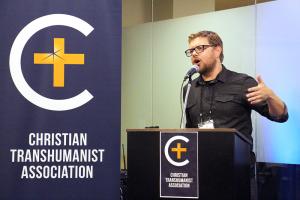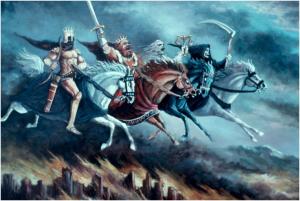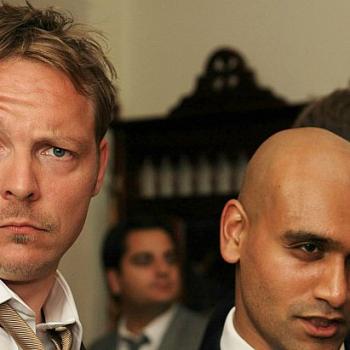 Religious Transhumanism? Yes.
Religious Transhumanism? Yes.
Evangelical Transhumanism? Yes.
H+ 4 / 1014
Both religion and transhumanism (H+) invite us to transformation. So, should these two partner with one another?
Transhumanists plan to transform the mind through artificial intelligence (AI) and intelligence amplification (IA). “The transhuman,” according to the Transhumanist Manifesto of 2008, “is a biological-technological organism, a transformation of the human species that continues to evolve with technology.”
Abraham’s descendants—Jews, Christians, and Muslims—plan to transform the heart through living a godly life. Can faith rely on H+ technology to live a godly life?
Here is one of my University of Chicago professors, Langdon Gilkey, on transformation.
“Every fundamental theological symbol means a critical stance toward past and present forms of existence and order in the social world, and the call to historical and social action on behalf of a new earth” (Gilkey 1976, 138).
Could technology help bring this transformation to pass? Devout religious transhumanists answer in the affirmative. Critics are skeptical.
It is the task of the public theologian–Noreen Herzfeld and Michael Burdett provide good examples–to analyze and evaluate the advancing frontier of technology to inform the theologian and to illuminate the wider public. And, this will be our task here as we ask: can an evangelical Christian be a religious transhumanist?
Religious Transhumanism and Its Critics
It’s imminent! The publication of Religious Transhumanism and Its Critics with Roman and Littlefield/Lexington edited by Arvin Gouw, Brian Patrick Green, and Ted Peters. We’ve been aiming at this Goliath for a half dozen years now. We’ve finally hit the mark.
Here in this Patheos series on public theology, we are constructing a scientifically informed vision of humanity’s future in light of God’s eschatological promises for ultimate transformation and renewal. In H+ 1, we asked whether AI could provide a shortcut to virtue or holiness? In H+ 2, we parsed the transhuman, the posthuman, and the truly human. In H+ 3, we distinguished Radical Life Extension, Cybernetic Immortality, and Resurrection of the Body. Here in H+ 4 we extend the discussion by adumbrating various commitments by various adherents to religious transhumanism. Critics too.
Let’s begin by asking: can an evangelical Christian ally with religious transhumanism? For our answer, you will meet Micah Redding and the Christian Transhumanist Association.
The Christian Transhumanist Association

The Christian Transhumanist Association (CTA) arose among Evangelical Protestants in 2014. Christian blogs merged with H+ and social media. What is the CTA mission? “We believe that God’s mission involves the transformation and renewal of creation.” This is followed by “we believe that the intentional use of technology, coupled with following Christ, will empower us to become more human.”
Let me call your attention to this wording: “more human.” Not “posthuman.”
For sparkplug Micah Redding, founder and president of CTA, H+ is not itself the end but rather a means for effective Christian mission. That mission includes spiritual progress, especially sanctification. “Christian Transhumanists will continue to advance the vision of a radically flourishing future that is good for all life” (Redding 2019, 794).
Yet, the Christian theologian dare not be naïve about anthropology, especially the doctrine of sin. When utopians forget about human sin, a not very hidden ice berg will sink the ship. So, Carmen Fowler LeBerge issues a warning.
“The Christian must ask (and be prepared to explain) what it means to the transhumanist to be human and we must also be prepared to expose the sin-side of their plans. For while there may be much good in longer life, sin remains and sin is prone to ruin good things and the good life so many pursue. We have to face the fact that people – even highly evolved people – have done, are doing and will continue to do horrible things” (LaBerge 2019, 775).
Meet Micah Redding
 Micah Redding is founder and executive director of the Christian Transhumanist Association (CTA). His work has been featured in places such as Christianity Today, BBC World Radio, and Vice Motherboard. His background is in software development, and he is currently pursuing an MSc in Philosophy, Science and Religion from the University of Edinburgh.
Micah Redding is founder and executive director of the Christian Transhumanist Association (CTA). His work has been featured in places such as Christianity Today, BBC World Radio, and Vice Motherboard. His background is in software development, and he is currently pursuing an MSc in Philosophy, Science and Religion from the University of Edinburgh.
I recently interviewed Micah for an organization you all should know about, AI and Faith. Here’s the original. This Patheos variant includes some modifications.
TP. Micah, what is the relationship between Artificial Intelligence (AI) and the Transhumanist (H+) movement? Why are these two forces so important to global society?
MR: Both AI and H+ challenge our conception of the boundaries of human nature, the first from the outside, and the second from within. As such, they each exert a profound, and often unseen, influence.
As AI progresses, it will create moments of significant public discussion, such as with GPT-3 coming online. But more significantly, as it spreads, it will reshape huge parts of our world in largely unnoticed, implicit, unconscious ways. We may only become aware of many of these effects years later.
H+, similarly, has moments of public focus, such as when Elon Musk advocates brain-computer interfaces, or discusses the Simulation Argument. But more significantly, H+ is upstream from many of the choices impacting our future. As a philosophical community, it formulates the visions and ethical principles that drive many of our society’s most powerful individuals and institutions. There is a relative vacuum in the world of serious, visionary, ethical-technological thought. H+ accessibly addresses that need, and as a result it has a disproportionate impact on our society and our future.
TP. As a devout evangelical Christian, Micah, what is it about transhumanism that attracts you? What is the positive connection between the H+ vision of the future and the Christian promise?
MR: Transhumanism is one of the few movements that unabashedly holds out hope for a positive, participatory, eschatological future. As such, it joins Christian writers like CS Lewis and GK Chesterton in critiquing our society for its failure to dream on a grand enough scale.
 “We are often too weak to desire that undying vigour. We believe that you can have too much of a good thing—a blasphemous belief, which at one blow wrecks all the heavens that men have hoped for.” — GK Chesterton [Four Horsemen of the Apocalypse by Al Federico 1978]
“We are often too weak to desire that undying vigour. We believe that you can have too much of a good thing—a blasphemous belief, which at one blow wrecks all the heavens that men have hoped for.” — GK Chesterton [Four Horsemen of the Apocalypse by Al Federico 1978]
Christianity, in its fullest and truest form, is the source of many of our most profound positive images for the future. It is these images that have historically drawn people in. But in our society, those images are often swallowed up by cynicism and superficial pragmatism, and ignored.
In contrast, transhumanism is often ready and eager to take those visions as marching orders. Although I may disagree with many of their applications and interpretations, it’s hard to find other modern movements which will take Christian images such as ‘the lion laying down with the lamb’ seriously as visions for our future.
When people are eager to make a positive difference, and are open to exploring the visions and images that should guide our future—that’s who I want to be working with, talking with, learning with.
TP. The purpose of the Christian Transhumanist Association is extremely ambitious: “Participating with God in the redemption, reconciliation, and renewal of the world.” How do you believe that advancing technology could contribute to redemption of the world?
MR: Christians have always employed technology in our efforts, from the agricultural products involved in the Communion or Eucharist, to the construction of hospitals to care for the sick, to the printing press as an aid in the propagation of scripture.
So the use of technology is a constant in Christianity. What’s at stake is whether we acknowledge it, and affirm it as part of our work and calling as image-bearers within God’s good creation.
A common viewpoint may see technology as simply a consumer product, to be used however it suits us. A truly Christian viewpoint recognizes and acknowledges technology as an outgrowth of being made in the image of a Creator.
As such, technology, just like every other aspect of our being, is part of God’s story of redemption.
TP. What is human nature?
TP. One of the indefatigable leaders in the field of Theology and Science has been Philip Hefner. According to Hefner, we human beings are God’s created co-creators. Hefner means, among other things, that our pursuit of technological advance gives expression to the imago Dei (the image of God). Would you formulate your theological anthropology similarly or differently?
 MR: Yes, I think that’s exactly right. The emphasis of Genesis 1 is on God as Creator, and on the formation of humans to reflect precisely that image.
MR: Yes, I think that’s exactly right. The emphasis of Genesis 1 is on God as Creator, and on the formation of humans to reflect precisely that image.
The language I like to use for this is “creative and relational”, because it’s not just about our ability, but also our responsibility and role to reflect God’s own mission within the created order.
Thinkers from St. Gregory of Nyssa to Sir Francis Bacon have emphasized that science and technology are part of the ways we bless the created order, and thus continue the work of God modeled for us in Genesis 1. From a secular perspective, I frequently point out that we are the only species on the planet who can deflect killer asteroids. From a Christian perspective, I think that’s exactly the kind of thing Genesis 1 says we are placed here to do.
TP. Is there anything about AI development and the future projected by H+ that worries you? Do you have any criticisms or warnings?
MR: One of my biggest concerns is the way in which (often legitimate) skepticism about future scenarios leads to disengagement from the discussions and decisions that are currently happening. Just like we’ve seen with the internet, many of the significant decisions are made before most people become aware of what these decisions actually mean. People who let early discussions of an “Intergalactic Network” keep them from taking it seriously, simply had no opportunity to offer input.
My second biggest concern is that the people who do anticipate where these things are going, often operate and strategize from fear. Nick Bostrom, of the Future of Humanity Institute at Oxford, focuses on all the ways super-intelligent AI could go bad. Eliezer Yudkowsky takes a similar approach, as does Elon Musk. For many people influenced by these perspectives, the answer is to perfect tools of torture and psychological enslavement, to be used to control our AI.
Such a strategy will certainly backfire. Either it will be used on actual AGI, which will learn these techniques from us, and then turn the tables; or it will be developed and used by some humans against others. In any case, the end result is the same nightmarish dystopia we were purportedly setting out to avoid.
Christianity offers a better answer here. “Do unto others as you would have a super-intelligent AI do unto you”, is a half-joking paraphrase I like to use. Nearly everything we do is a data-set for some future AI. We should make sure it is learning something positive and good.\
TP. The Transhumanism Handbook (Springer 2019) is perhaps the most comprehensive work on the H+ movement, including religious assessments and evaluations. How satisfied are you with this volume? Do you have plans for any future such publications?
MR: One of the great things about the Transhumanism Handbook is the way in which it was able to reflect angles on the transhumanist movement not usually explored. The religious angle is more significant than most people realize, not just from transhumanism’s external engagement with religious thought, but also from the ways in which the religious impulse is intrinsic to what transhumanism is.
As part of that exploration, I’m looking forward to contributing to Religious Transhumanism and Its Critics, with Ted Peters, Brian Patrick Green, and Arvin Gouw. I’ll have a chapter in that volume.
I’ve also been doing research on the history and precursors of secular transhumanism. Secular transhumanism very explicitly draws on religious influences and sources in the 20th century, but its visions and aims are a much greater aspect of the 17th century scientific revolution than is typically realized. For example, both Francis Bacon and Robert Boyle contemplate life extension as a key aspect of their scientific and religious work. I hope to eventually publish on the ways in which the scientific revolution can be seen as a transhumanist revolution, inspired by the ongoing reformations in religion itself.
Revising the CTA Mission?
Here is what Micah Redding has been pondering on social media regarding a refinement of the CTA mission.
These are our three missions. A theological mission, to explain how science and technology fit into the purpose of Christ and of God. A faith-renewing and revitalizing mission, to show how the future can renew our faith. A technological mission, to advocate the ethical vision of Christ for science and technology.
Conclusion

I share with transhumanists an enthusiasm for a transforming future. I also share an excitement for technological progress. In addition, I share with Micah Redding and Philip Hefner too an anthropology which describes the human race as God’s created co-creator. For all these reasons, an evangelical Christian ought to find transhumanism attractive. [World Heart by Madi, Bali]
Yet, I am wary. It is my own view that the utopian endgame of secular transhumanism is based on a false scientific assumption regarding the relationship between evolution and progress. We Homo sapiens sapiens are not destined by evolutionary principles to evolve into a utopian state. Extinction through self-destruction is just as likely as unfettered technological progress. We dare not forget this.
Concomitant to this is the following: H+ is naïve when underestimating the human capacity for destructive evil. No amount of technical advance can either liberate human race from its current sinful state or police our propensity for prostituting every technology in the service of injustice.
With these qualifications in mind, I remain cautiously optimistic. Insofar as the transhumanists march toward making our world a healthier place, I plan to cheer (Peters, 2019; 2022).
▓
 Ted Peters directs traffic at the intersection of science, religion, and ethics. Peters is an emeritus professor at the Graduate Theological Union, where he co-edits the journal, Theology and Science, on behalf of the Center for Theology and the Natural Sciences, in Berkeley, California, USA. He authored Playing God? Genetic Determinism and Human Freedom? (Routledge, 2nd ed., 2002) as well as Science, Theology, and Ethics (Ashgate 2003). He is editor of AI and IA: Utopia or Extinction? (ATF 2019). Along with Arvin Gouw and Brian Patrick Green, he co-edited the new book, Religious Transhumanism and Its Critics hot off the press (Roman and Littlefield/Lexington, 2022). Soon he will publish The Voice of Christian Public Theology (ATF 2022). See his website: TedsTimelyTake.com.
Ted Peters directs traffic at the intersection of science, religion, and ethics. Peters is an emeritus professor at the Graduate Theological Union, where he co-edits the journal, Theology and Science, on behalf of the Center for Theology and the Natural Sciences, in Berkeley, California, USA. He authored Playing God? Genetic Determinism and Human Freedom? (Routledge, 2nd ed., 2002) as well as Science, Theology, and Ethics (Ashgate 2003). He is editor of AI and IA: Utopia or Extinction? (ATF 2019). Along with Arvin Gouw and Brian Patrick Green, he co-edited the new book, Religious Transhumanism and Its Critics hot off the press (Roman and Littlefield/Lexington, 2022). Soon he will publish The Voice of Christian Public Theology (ATF 2022). See his website: TedsTimelyTake.com.
▓
Bibliography
Gouw, Arvin. 2022. “Transhumanism: Good Science? Bad Science? Pseudo-Science?” In Religious Transhumanism and Its Critics, by Brian Patrick Green, and Ted Peters, eds Arvin M Gouw, Chap 18. Lanham MA: Lexington.
Gilkey, Langdon, 1976. Reaping the Whirlwind. New York: Crossroad.
Green, Brian Patrick. 2022. “A Roman Catholic View: Technological Progress? Yes. Transhumanism? No.” In Religious Transhumanism and Its Critics, by Brian Patrick Green, and Ted Peters, eds Arvin M Gouw, Chap 9. Lanham MA: Lexington.
LaBerge, Carmen Fowler. 2019. “Christian? Transhumanist? A Christian Primer for Engaging Transhumanism.” In The Transhumanism Handbook, by ed. Newton Lee, 771-776. Switzerland: Springer.
Peters, Ted. 2019. “Artificial Intelligence, Transhumanism, and Rival Salvations.” Covalence https://luthscitech.org/artificial-intelligence-transhumanism-and-rival-salvations/.
Peters, Ted. 2019. “Boarding the Transhumanist Train: How Far Should the Christian Ride?” In The Transhumanist Handbook, by ed. Newton Lee, 795-804. Switzerland: Springer.
Peters, Ted. 2022. “Homo Deus or Frankenstein’s Monster? Religious Transhumanism and Its Critics.” In Religious Transhumanism and Its Critics, by Brian Patrick Green, and Ted Peters, eds Arvin M Gouw, Chap 2. Lanham MA: Lexington.
Redding, Micah. 2019. “Christian Transhumanism: Exploring the Future of Faith.” In The Transhumanism Handbook, by ed. Newton Lee, 777-794. Switzerland: Springer.
Redding, Micah. 2022. “Why Christian Transhumanism?” In Religious Transhumanism and Its Critics, by Brian Patrick Green, and Ted Peters, eds Arvin M Gouw, Chap 7. Lanham MA: Lexington.

















